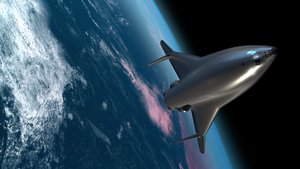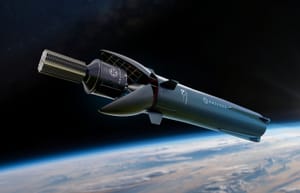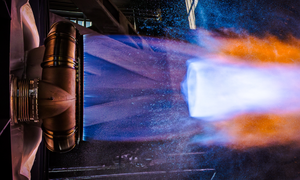
Apr 4, 2024
Radian One - Another attempt towards the holy grail?
American aerospace startup, Radian Aerospace re-introduced its Radian One single-stage-to-orbit spaceplane to the world recently via a series of posts on X and Linkedin. Single-stage to orbit vehicles have long been considered as one of the holy grails of rocketry, due to a lack of complex staging events and aircraft-like potential operations.
Radian had previously announced Radian One back in January of 2022 when it emerged from 'stealth mode' after it raised 27.5 million United States dollars in funding. Fine Structure Ventures reportedly led its first funding round with EXOR, The Venture Collective, Helios Capital, SpaceFund, Gaingels, The Private Shares Fund, Explorer 1 Fund, Type One Ventures and other investors contributing too.

Radian One is being developed as a single-stage-to-orbit spaceplane that will be launched from a rocket sled on Earth. For landing, the spaceplane is claimed to be able to land on 'compatible' runways worldwide. Radian also lists some impressive claims for the spaceplane:
- Fully reusable for up to 100 missions
- 90-minute on demand capability
- 48-hour turnaround between flights
- Industry-leading downmass capability
- Designed for dual-use applications
These claims, while impressive, will be hard to prove until more hardware is built and tested for the spaceplane. So far Radian has only shown progress on a small tank and a heat tile material publically. However the claim of "industry-leading downmass capability" is debatable while SpaceX's Starship vehicle is in development and not far from operation, along with similar vehicles in China. The current operational leader for downmass from space is SpaceX's Cargo Dragon V2 spacecraft with a capacity of 2,507 kilograms.
To reach the claims of "48-hour turnaround", "reusable for up to 100 missions", and "90-minute on demand capability" Radian will have to prove these claims once they start flying. Their spaceplane is likely designed around these claimed capabilities. By "90-minute on demand capability" Radian likely means that they will be capable of launching under 90 minutes from receiving the go-to-launch call from a customer, this is also a capability the United States military is highly interested in.
The claim of "dual-use applications" is likely similar to what the Space Shuttle would have done on some of its missions. NASA's Space Shuttle flew missions during its flight history where it would perform various science and deploy spacecraft in the same mission. For Radian this could be hosting multiple customer missions on the same spaceplane.

Due to the constraints of being a single-stage-to-orbit system, Radian One will launch with the assistance of a 2-mile-long rocket sled to help the spacecraft gain speed, partially under its own power. After reaching a currently undisclosed speed, the spaceplane will be released from the sled and ascend to orbit using its five engines. Once in space, it is believed the spaceplane will use a smaller and more efficient engine to maneuver into different orbits, or to rendevous with a space station.
Radian has shared few official details on the vehicle but has listed the following; the spaceplane will carry a minimum of two crew with a maximum of five, it will be able to carry 2,270 kilograms of cargo into low Earth orbit, and it will be able to return 4,540 kilograms of cargo back to Earth from orbit. They also list the dimensions of the payload bay as: 5.2 meters long, 3.8 meters wide at the front with it being 5.6 meters wide at the back, and 2.7 meters tall at the front with it being 4.0 meters tall at the back, for a payload bay volume of approximately 93 meters cubed.
The next generation of launch has arrived. Meet #RadianOne. pic.twitter.com/QBXY4c0zc9
— Radian Aerospace (@RadianSpace) April 3, 2024
Radian Aerospace's promotional video of Radian One showcasing its operations via Radian Aerospace on X
What Radian chose not to share was the fuel choice, any engine specifics, or dimensions for the vehicle. This is understandable as the spaceplane is still in early development with a believed debut flight planned for 2030.
Based off of the promotional video, Radian One may be utilizing an extendable nozzle to improve engine performance through ascent. The extendable nozzle is not a new idea with it being used most notable for the RL-10 series of engines, in order to decrease its size prior to staging. For Radian's use case, it likely allows for a 'higher thrust' mode early into ascent and a 'higher efficiency' mode later in ascent.
Also based off of the video and current industry trends, Radian One could be planning to use liquid methane and liquid oxygen as the rocket plumes match that of an engine burning those fuels. The launch industry has been shifting towards liquid methane as rocket fuel for a little over a decade, due to it having close to the efficiency of liquid hydrogen engines and the thrust of rocket-grade kerosene engines. However, the plume color could have been an artistic choice.

Building a single-stage-to-orbit vehicle is a difficult engineering and material science challenge with the most well-known attempt being NASA and Lockheed Martin's Venture Star vehicle. Radian will have to develop a lightweight heat tile to protect the spaceplane from the immense heat of re-entry into the atmosphere, this heat tile is unlikely to be made of an ablative material due to the desired turnaround time. They also have to develop fuel tanks that are light enough for the spaceplane to lift under its own power to allow it to achieve orbital velocity. Radian also has the added challenge of making the vehicle safe for humans to travel aboard.
Who is Radian Aerospace?
Radian Aerospace is a Washington-based aerospace company operating in the United States. The company is working on what they call a next-generation aerospace vehicle which may be the world’s first fully reusable horizontal takeoff and landing single-stage-to-orbit spaceplane.




